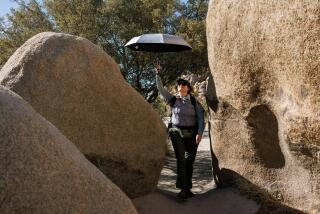New Thai National Park Fights to Save Tigers
- Share via
KHAO YAI, Thailand — As night draws in and wildlife stirs in the deep forest, park rangers in camouflage roll out of their hammocks, pick up their rifles and head off to fight what environmentalists fear is a losing battle--saving Thailand’s tigers.
The haunting calls of barking deer echo through the darkness as a team of seven protectors of Khao Yai, Thailand’s oldest national park, takes a moonlit trail and waits for the unexpected: maybe a wild elephant crossing the path, or a professional poacher with an assault rifle.
The rangers are armed with M-16s, but also rely on their knowledge of the mountainous jungle and powers of persuasion to stop hunters in an area that is home to some of Asia’s most endangered species.
Somphone Chayakal, a ranger in Khao Yai for 15 years, remembers when tigers used to prowl around his station every week or two. Now they are rarely seen. Experts fear there could be a dozen or fewer left within the park’s 846 square miles.
According to anecdotal accounts, animals like wild elephants, sambar deer and gaur have also suffered. One local ex-poacher, once famous as an elephant hunter in Thailand and Malaysia, estimates animal populations in the park have been halved over the last decade.
A new project partly financed by the U.S. government is training 28 rangers. They learn such skills as disarming poachers and setting up infrared cameras to record the different species that still survive across Khao Yai, which straddles four provinces in central Thailand.
The World Conservation Society and WildAid, two U.S.-based groups, have designed what they hope can be a prototype for wildlife preservation in nature reserves across Asia, combining scientific study with community education and a crackdown on both illegal hunting and woodcutting.
Steven Galster of Green Lake, Wis., a co-director of WildAid who has helped run conservation projects in Myanmar, Russia, Ecuador and India, said the idea is to teach local people about the dangers of overusing nature and to tackle hard-core poachers head-on.
Poachers can be armed with anything from antiquated muzzle-loading muskets reminiscent of Daniel Boone to modern military assault rifles. In November, one Khao Yai ranger died in a clash with a poaching gang.
“We can’t eradicate poaching, but we can disrupt it,” Galster said. “We will encourage the subsistence poachers to stop and find other ways of generating extra income, and focus our law enforcement efforts on the serious commercial operators.”
The main draw for wood thieves in Khao Yai is the scented aloe wood, known locally as “maihom,” for which the park is famous. The highest-quality wood, rich with black fungus, sells for as much as $240 a pound and is hacked from forest trees for processing into perfumed oil that fetches high prices in Japan, Korea and the Middle East.
As many as 300 poachers are believed to be in the park at any one time, staying for as long as a month. Some are big-time, heavily armed operators, but most are impoverished locals, who in a 10-day trip into the bush may earn as little as $26 from selling aloe wood to factories that ring Khao Yai.
The poachers shoot game mostly to feed themselves, but that robs the predatory tigers of what they need to survive.
“Hunters aren’t actually going out and targeting tigers in Thailand anymore, but they threaten them by poaching their prey,” said Tony Lynam, a zoologist from Perth, Australia, who is director of the World Conservation Society program in Thailand.
Thailand is at the center of the tiger’s global habitat, but of the estimated 5,000 tigers left in Asia, few are thought to survive here.
In Khao Yai, they roam huge distances to stay alive. Camera traps set up over the last year took about 10 tiger pictures in a large tract at the center of the park, but each photo captured the same beast.
Seeking to gain an edge on the hunters, the preservation project has recruited ex-poachers who have a unique knowledge of the jungle trails and the behavior of wildlife, and insight into the ways of the forest’s human predators.
But it’s risky to share trade secrets. At least one Khao Yai poacher who went to work on an earlier conservation project was shot dead.
“My colleagues, including my relatives, are still out there poaching,” said one man who now works for the project but used to lead a team that collected aloe wood across Thailand and Cambodia. He declined to be identified--for safety reasons, he said.
“Some people want to change, but they need to get money to send their kids to school, or to pay off debts,” he said. “They go into the jungle to stop their families from going hungry.”
In the hope of forestalling a new generation of poachers, the project is inviting local schools to bring children to the park, which many youngsters know little about even though it lies on their doorstep.
*
On the Net:
Status of tigers: https://user.aol.com/tigertrail/ichinese.htm and https://www.5tigers.org/
More to Read
Sign up for Essential California
The most important California stories and recommendations in your inbox every morning.
You may occasionally receive promotional content from the Los Angeles Times.













